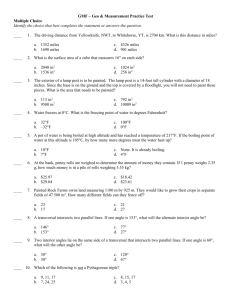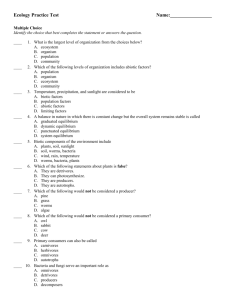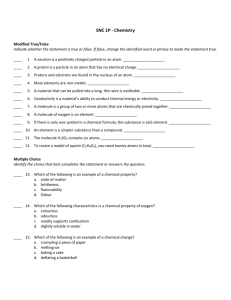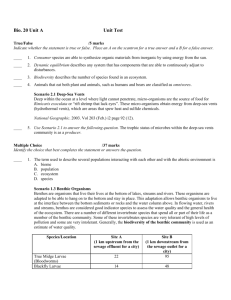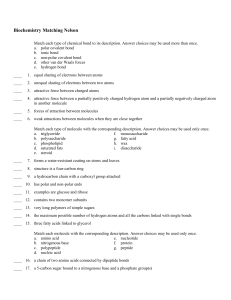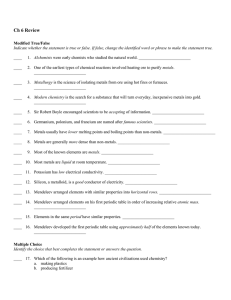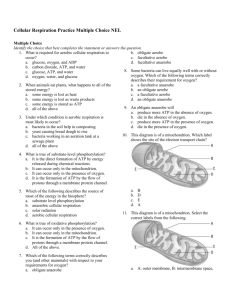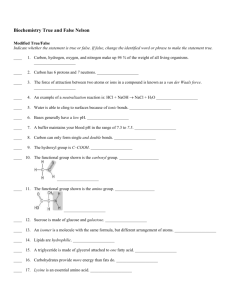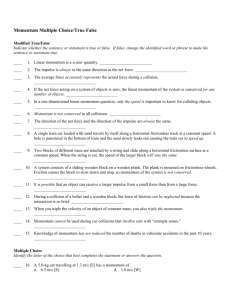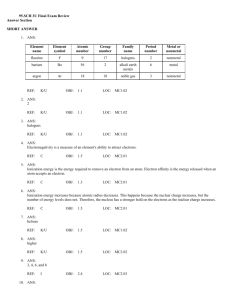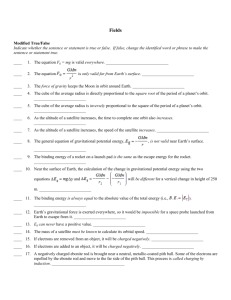Chapter 10 & 11 Practice Test Answer Section
advertisement
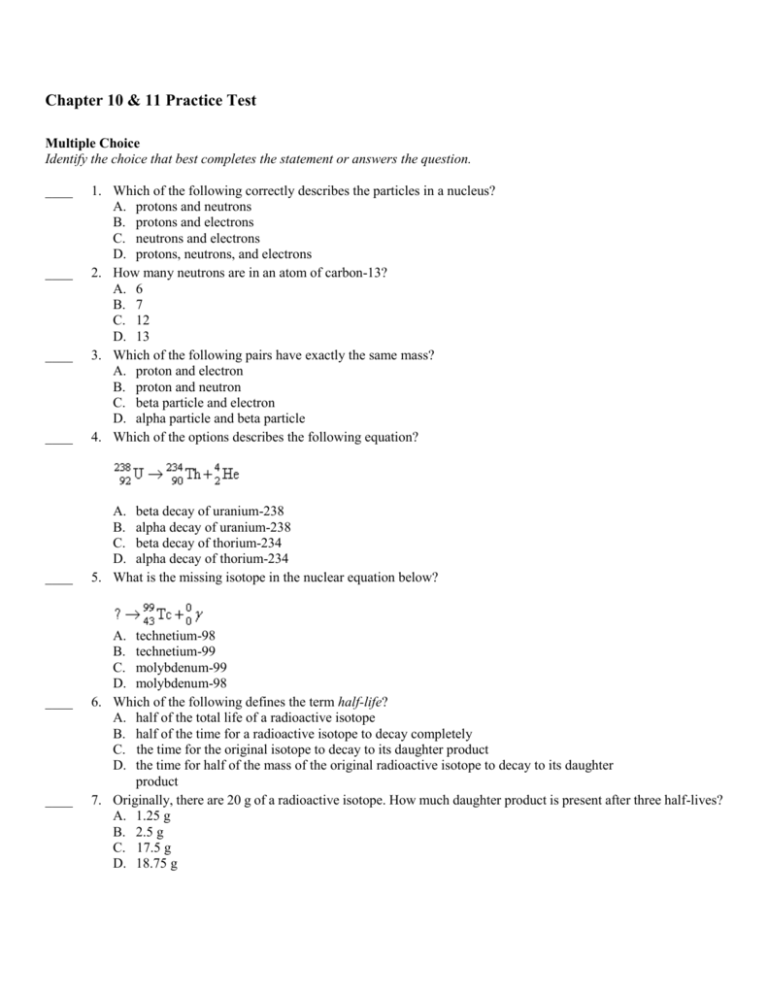
Chapter 10 & 11 Practice Test Multiple Choice Identify the choice that best completes the statement or answers the question. ____ ____ 1. Which of the following correctly describes the particles in a nucleus? A. protons and neutrons B. protons and electrons C. neutrons and electrons D. protons, neutrons, and electrons 2. How many neutrons are in an atom of carbon-13? A. 6 B. 7 C. 12 D. 13 3. Which of the following pairs have exactly the same mass? A. proton and electron B. proton and neutron C. beta particle and electron D. alpha particle and beta particle 4. Which of the options describes the following equation? ____ A. beta decay of uranium-238 B. alpha decay of uranium-238 C. beta decay of thorium-234 D. alpha decay of thorium-234 5. What is the missing isotope in the nuclear equation below? ____ ____ ____ ____ A. technetium-98 B. technetium-99 C. molybdenum-99 D. molybdenum-98 6. Which of the following defines the term half-life? A. half of the total life of a radioactive isotope B. half of the time for a radioactive isotope to decay completely C. the time for the original isotope to decay to its daughter product D. the time for half of the mass of the original radioactive isotope to decay to its daughter product 7. Originally, there are 20 g of a radioactive isotope. How much daughter product is present after three half-lives? A. 1.25 g B. 2.5 g C. 17.5 g D. 18.75 g Figure 10.1 Mass of Cesium-124 versus Time ____ 8. In Figure 10.1, how much of the decay parent product is left after 2.5 half-lives have passed? A. 2.5 mg B. 3.7 mg C. 5.0 mg D. 10.0 mg ____ 9. If an isotope of lead-214 undergoes beta decay and then the product undergoes beta decay, which of the following will result? A. polonium-214 B. bismuth-214 C. thallium-214 D. mercury-214 ____ 10. Which of the following is the missing number that will balance the nuclear equation shown below? A. 1 B. 2 C. 3 D. 4 ____ 11. Which of the following is the missing number that will balance the nuclear equation shown below? A. 144 B. 145 C. 146 D. 147 ____ 12. Which of the following explains the need for fresh water in a nuclear power plant? A. to be turned into steam to turn turbines B. to cool the reactor core during operation C. to control the rate of the nuclear reaction D. to absorb some of the neutrons to maintain the rate of reaction ____ 13. Which of the following describes the energy produced when uranium under goes fission? A. less than the energy produced by a burning match B. much more than the energy produced by a burning match C. about the same as the energy produced by a burning match D. somewhat more than the energy produced by a burning match ____ 14. Which of the following describes the condition of critical mass when considering the reaction below? A. All of the produced neutrons cause further fission reactions. B. An average of 2 of the produced neutrons cause further fission reactions. C. An average of 1 of the produced neutrons causes further fission reactions. D. An average of less than one of the produced neutrons causes further fission reactions. ____ 15. Which of the following describes nuclear fusion? A. combining two small nuclei to make one large nucleus B. combining two large nuclei to make one larger radioactive nucleus C. the splitting of one large nucleus into two smaller nuclei D. the splitting of one large nucleus into one slightly smaller nucleus and a helium nucleus ____ 16. Which of the following explains where the energy comes from in a nuclear fusion reaction? A. The reaction is exothermic. B. The reaction is endothermic. C. Mass of the products is less than the reactants. D. Mass of the products is more than the reactants. ____ 17. Which of the following shows correct differences between fission and fusion? A. Product isotopes of fusion are larger than the products of fission. B. Product isotopes of fission are smaller than the products of fusion. C. Product isotopes of fusion will decay many times after the first fusion reaction. D. Product isotopes of fission will decay many times after the first fission reaction. Chapter 10 & 11 Practice Test Answer Section MULTIPLE CHOICE 1. ANS: LOC: 2. ANS: LOC: 3. ANS: LOC: 4. ANS: LOC: 5. ANS: LOC: 6. ANS: LOC: 7. ANS: LOC: 8. ANS: LOC: 9. ANS: LOC: 10. ANS: LOC: 11. ANS: LOC: 12. ANS: LOC: 13. ANS: LOC: 14. ANS: LOC: 15. ANS: LOC: 16. ANS: LOC: 17. ANS: LOC: A C5.01 B C5.01 C C5.03 B C5.06 B C5.06 D C5.04 C C5.04 B C5.04 A C5.04 C C6.06 B C6.06 A C5.06 B C5.06 C C5.06 A C5.05 C C5.05 D C5.05 PTS: TOP: PTS: TOP: PTS: TOP: PTS: TOP: PTS: TOP: PTS: TOP: PTS: TOP: PTS: TOP: PTS: TOP: PTS: TOP: PTS: TOP: PTS: TOP: PTS: TOP: PTS: TOP: PTS: TOP: PTS: TOP: PTS: TOP: 1 CH10 KI1 1 CH10 KI1 1 CH10 KI3 1 CH10 KI3 1 CH10 KI3 1 CH10 KI3 1 CH10 KI4 1 CH10 KI4 1 CH10 KI4 1 CH11 KI2 1 CH11 KI2 1 CH11 KI4 1 CH11 KI4 1 CH11 KI4 1 CH11 KI3 1 CH11 KI4 1 CH11 KI3 REF: K OBJ: 10.2 REF: U/A OBJ: 10.2 REF: HMP OBJ: 10.3 REF: U/A OBJ: 10.3 REF: U/A OBJ: 10.3 REF: U/A OBJ: 10.4 REF: U/A OBJ: 10.4 REF: HMP OBJ: 10.4 REF: HMP OBJ: 10.4 REF: U/A OBJ: 11.2 REF: U/A OBJ: 11.2 REF: U/A OBJ: 11.3 REF: U/A OBJ: 11.3 REF: HMP OBJ: 11.3 REF: K OBJ: 11.5 REF: U/A OBJ: 11.5 REF: U/A OBJ: 11.5









